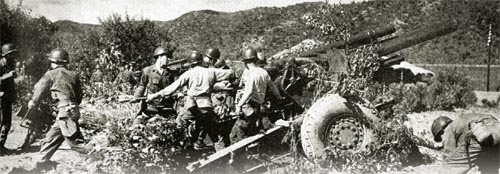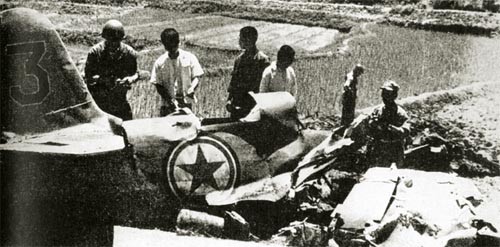HOW THE WAR BEGAN
Acquiring the tools of war
Last week, General Paik described encountering U.S. soldiers as the ROK Army withdrew from Suwon to Daejeon.

Soldiers of the U.S. 24th Infantry Division fire rounds from their 155 millimeter howitzer towards Cheonan, South Chungcheong. Provided by Gen. Paik Sun-yup
They numbered in the hundreds. I think I addressed the long-lost troops with something to the effect of: “I am extremely happy. Let’s work on recovering our strategic strength and fight our enemies again.”
They seemed just as pleased to reunite with their commanding officer and responded with a spirited shout.
We headed toward Cheongju, North Chung-cheong. We had to continue to stall for time until American and UN troops could provide us with support and we were reduced to engaging in “hit and run” tactics to minimize casualties and maximize kills.
We passed Cheongju and arrived in Jeungpyeong, North Chungcheong, where the ROK 6th Division was stationed. They had gained the respect of others for their efforts in holding the line in Chuncheon. Their work deserves to be recorded as one of the great achievements in history. Chuncheon was a key defense point, especially considering it was a key outpost for the central area.

U.S. Army investigators inspect a Soviet Yak fighter airplane just south of Seoul on July 7, 1950. It was the first known enemy fighter plane shot down during the Korean War. In order to disguise Soviet support in the war, the North Koreans painted their Air Force logo over the Soviet one. Provided by the U.S. Army
When we met them, the commander of the ROK 6th Division, Col. Kim Jong-oh, and his adviser Maj. Yoo Yang-su were beaming with confidence. Having requisitioned trucks from a coal mining company prior to the start of the war, the ROK 6th Division was capable of speedy mobilization of its men. As our division was short of the basic necessities, such as firearms and combat gear, we envied them.
There was more to the heroic efforts of the 6th Division. After relocating from Chuncheon to Eumseong, North Chungcheong, the ROK 6th Division, 7th Regiment, 2nd Battalion, was successful in wiping out an entire North Korean regiment. The 2nd Battalion had been tipped off by a female elementary school teacher in the area to the North Korean regiment’s whereabouts and was able to carry out a successful ambush.
On July 8, 1950, the ROK 1st Division and the 7th Regiment of the ROK 6th Division took turns holding the line in Eumseong. Lt. Maj. Lim Bu-taek, the commander of the 7th Regiment, was just coming off of a resounding victory at the Battle of Dongrak-ri and was full of confidence.
Knowing that my division was not fully prepared to defend an enemy assault at this point, I requested Lim’s help out of desperation. Lim accepted my request without a moment’s hesitation. With the 7th Regiment’s artillery providing cover, the ROK 1st Division was able to ward off a strong offensive from the North Korean troops.
To this day, I still feel indebted to Lim for his support. I found out later that Lim got into hot water with his division commander, Kim Jong-oh. Kim was said to have lashed out at Lim for not following orders and carrying out his own strategic plan.

The 50,000:1 scale map, left, and 600,000:1 scale map used by General Paik during the early stages of the Korean War. More detailed maps are used in cases of smaller battles but the 50,000:1 scale map is the most commonly used map in the military. Provided by Gen. Paik Sun-yup
Col. Horton V. White, the regimental commander of the all African-American 24th Infantry Regiment and I had met before. Prior to the start of the war, while I was working for the National Intelligence office, White was an intelligence officer with the 24th Infantry Regiment occupational force, which was in Korea following liberation from Japan. We joked that we had the same last name, with Paik translating to “white” in English. Colonel White was over 50 years old at the time.
With regard to leading a group of young men, White used to lament about the mountainous regions of Korea: “War is for the young. I’m too old to be climbing high altitudes.”
After parting ways with Colonel White, I was stopped in my tracks by Col. Choi Young-hee, the commander of 15th Regiment.
“There’s a huge artillery gun over there,” an excited Choi exclaimed.
Choi was referring to the American 155 millimeter howitzer that we had only heard about. I rushed over to take a look and came across the artillery gun with one of its wheels stuck in a ditch. Up until the outbreak of the Korean War, the ROK Army had 105 millimeter howitzers its possession. Now I had my eyes fixed on the 155 millimeter howitzer, which had a superior maximum range and firepower. It was a weapon with capabilities that were unimaginable to us at the time.
Another problem we faced was the maps in our possession. We were doing our strategic planning on maps with a scale of 600,000:1 that we had acquired in abandoned elementary school classrooms during our retreat from the Imjin River.
I went back to Colonel White and asked for one of the maps in his possession. Colonel White replied he had plenty of maps and said that he would provide us with some of them.
The map of Korea being used by the U.S. Army at the time was devised by the Japanese during the colonial years and was to the scale of 50,000:1. The map revealed small streams and hills as well as roads that were not visible on our maps.
It was something that I was most envious of whenever I came across American soldiers - even more than the C ration that could fill the stomachs of our hungry soldiers and the Lucky Strike cigarettes of which American soldiers always seemed to have plenty.
It was impossible to ask to use any of their weapons or equipment but I continuously asked for the maps whenever I had the chance.
Planning out military strategies on a large scale map rather than a detailed 50,000:1 scale map is like night and day.
In the post World War II period, the American occupational forces in Tokyo, Japan, came across a negative of the map. They alerted the South Korean government and the government officials used the negative to print copies of the map. However, the map was never distributed to military personnel, who perhaps needed it more than anyone else.
During my stay with the National Intelligence office in 1948, I asked to have the map printed and distributed to key military divisions. Hence, the key military regiments and divisions were able to use the map to carry out strategic planning during the early stages of the war. But these maps were old-fashioned when compared to the ones used by the American troops.
First, our maps were printed in black and white while the maps of the Americans were in color. More importantly, the American maps had detailed coordinates. Our maps did not have such details. To me, it was groundbreaking stuff. While studying the map, many thoughts crossed my mind. To think we had been using other maps was laughable. In other words, it was an eye-opening experience.
It was amazing that we were able to fight in the war for a certain period of time without an appropriate map. It was only because we were fighting in our own backyard. Most of us were familiar with the area we were stationed in and knew where to find the rice, wild herbs and other things necessary for survival amidst the less than favorable conditions of the battlefields. Not many of us would have survived if we had had to fight under the same conditions on foreign soil.
The newly-acquired map and the 155 millimeter howitzer seemed like a sign that we were now capable of planning modernized tactics. Although we had the 50,000:1 scale maps, they were not delivered to all the ROK bases upon liberation from Japan. Although we used artillery rifles and howitzers of various sizes, we were far removed from modern warfare.
Just before there was an incident at Miwon, just south of Hwaryeongjang. We had set up a forward command post in the area. I was suddenly approached by Col. Choi Kyung-rok, the commander of the 11th Regiment, and Maj. Kim Dok-jun, both of whom spoke of their intention to leave the division. Brig. Gen. Kim Seok-won, whom the two officers had served prior to the outbreak of the war, had been reinstated as the commander of the Capital Division in early July. Now Colonel Choi and Major Kim were informing me of their decision to serve Brigadier General Kim again.
Such actions were acceptable during the chaotic days of the war. Once a person moved to the division of their choice, the commander in charge would simply make a call and explain they were needed.
In a way, it was my fault for being pushed off the line near the Imjin River and being forced to march 300 kilometers in retreat. Still, it hurt when the men under my command would leave me at a time when the division was at its weakest.
That night in Hwaryeongjang, I went to bed with the thought of the 155 millimeter howitzer and the map on my mind. I decided to forget about the two officers who had decided to leave my command, for the moment.
60 years with the military, by Paik Sun-yup
Translation by Jason Kim [jason@joongang.co.kr]










with the Korea JoongAng Daily
To write comments, please log in to one of the accounts.
Standards Board Policy (0/250자)